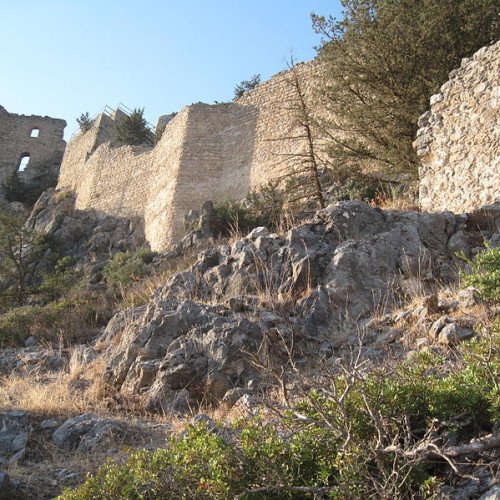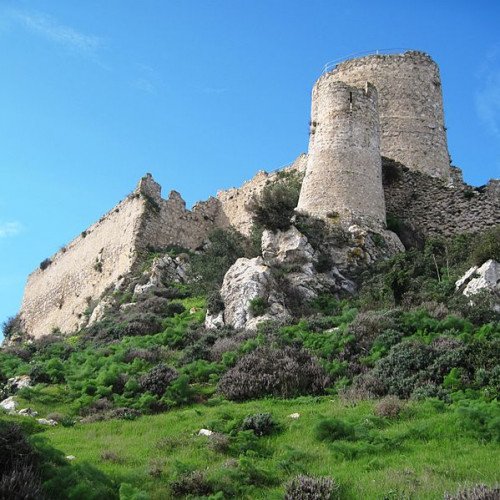Castles of "Cyprus" BUFFAVENTO CASTLE vs KANTARA CASTLE

BUFFAVENTO CASTLE
Buffavento Castle (Greek: Kάστρο Βουφαβέντο, Turkish: Buffavento Kalesi) is a castle in Northern Cyprus. The exact date of its construction remains unknown, the most plausible theory being the Byzantine period. It combines Byzantine and Frankish architectural elements. It fell into disuse in the 14th century. Buffavento stands between St. Hilarion Castle to the west and Kantara Castle to the east forming a protective axis in the Kyrenia mountain range of Northern Cyprus. Buffavento guarded the mountain passage from Kythrea to the north coast in particular. As both of the other castles are visible from Buffavento, it was used to pass signals between them. The castles were built in conjunction during the Byzantine period, however the exact date of their commission remains unknown. Noting the middle Byzantine (11th-12th century) architectural features present in the castle and the otherwise scarcity of archaeological evidence, D.M. Metcalf writes that "it is reasonable" to suggest that the castle was built with the St. Hilarion Castle as part of a major programme of works in the wake of the Seljuk advance in the late 11th century. Among the other theories put forward to explain their origin the popular are: In 965 (after the expulsion of the Arabs from the island), in 1091 by the rebel Rapsomates, during the rule of Eumathios Philokales (1091–1094), at the beginning of the 12th century as a countermeasure for the spread of the Crusader states. A Lusignan period legend claims that the castle was built by a Cypriot noblewoman who was seeking shelter from the Knights Templar in 1191, as such the castle was known as Leonne (Lion's Castle) or Queen's Castle. The name Buffavento is of Italian origin and means “Defier of the Winds", the name may have been borrowed from a monastery in the Koutzoventi village. Serving mainly as a watchtower for pirate raids and a place of incarceration the castle saw next to no fighting. In 1191, it was taken by Richard the Lionheart during his campaign against the island's ruler Isaac Komnenos of Cyprus. Since the castle's defenses have been described as very strong it is believed that the defenders of Buffavento surrendered after Kantara and St. Hilarion fell into English hands. Richard subsequently sold the island to the Knights Templar whose rule abruptly ended after a major revolt in Nicosia. Cyprus was thus resold to the Guy of Lusignan of the House of Lusignan. A period of peace ended with the death of Hugh I of Cyprus in 1218. A struggle over who should act as the kingdom's regent ensued, pitting the House of Ibelin with the local supporters of Frederick II, Holy Roman Emperor. Frederick's arrival in Limassol in 1228 escalated the conflict into an open war. Between 1229 and 1233, it changed hands several times between the Ibelins and their rivals. Afterwards, the Lusignans continued their reign interrupted only by occasional palace coups.
Statistics for this Xoptio

KANTARA CASTLE
Kantara Castle (Greek: Κάστρο της Καντάρας Turkish: Kantara Kalesi) is a castle in north Cyprus. The exact date of its construction remains unknown, the most plausible theory being the Byzantine period. It combines Byzantine and Frankish architectural elements, became derelict in 1525 and was dismantled in 1560. It gave its name to the nearby Kantara monastery. Kantara is situated to the east of the Buffavento Castle with the St. Hilarion Castle standing even farther to the west forming a protective axis in the Kyrenia mountain range of Northern Cyprus. As both of the other castles are visible from Buffavento, it was used to pass signals between them. The castles were built in conjunction during the Byzantine period but the date of their commission remains unknown. Among the theories put forward to explain their origin the popular are: In 965 (after the expulsion of the Arabs from the island), in 1091 by the rebel Rhapsomates, during the rule of Eumathios Philokales (1091–1094), in the late 11th century after the Cilician coast was overrun by the Seljuk Empire or in 1096 as a countermeasure for the upheaval caused by the First Crusade. The name of the castle derives from the Cypriot Maronite Arabic word kandak which means stone bridge. Serving as a watchtower for pirate raids, an administrative centre and a place of incarceration the castle saw next to no fighting. In 1191, it was taken by Richard the Lionheart during his campaign against the island's ruler Isaac Komnenos of Cyprus. Richard subsequently sold the island to the Knights Templar whose rule abruptly ended after a major revolt in Nicosia. Cyprus was thus resold to Guy of Lusignan, the former king of Jerusalem who became the first king of Cyprus in 1192. A period of peace ended with the death of Hugh I of Cyprus in 1218. A struggle over who should act as the kingdom's regent ensued, pitting the House of Ibelin with the local supporters of Frederick II, Holy Roman Emperor. Frederick's arrival in Limassol in 1228 escalated the conflict into an open war. In 1229, the castle came under siege by the Ibelins, who bombarded it with trebuchets, reportedly destroying several buildings. The castle's garrison surrendered a year later when its commander Gauvain de Cheneche was killed by a crossbow bolt. Afterwards, the Lusignans continued their reign interrupted only by occasional palace coups. In 1373, Cyprus was invaded by the Republic of Genoa imprisoning the local nobility. According to Philip of Novara's chronicle prince John of Antioch managed to escape from Famagusta after disguising himself as the valet of his cook. John subsequently fled to Kantara, from which he organised a successful counter offensive that expelled the Genoese after the latter failed to capture Kantara.